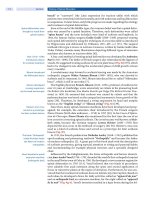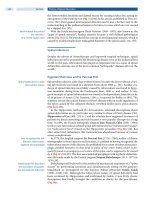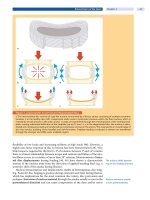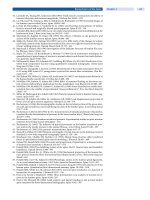Spinal Disorders: Fundamentals of Diagnosis and Treatment Part 4 docx
Bạn đang xem bản rút gọn của tài liệu. Xem và tải ngay bản đầy đủ của tài liệu tại đây (931.01 KB, 10 trang )
Historical Case Introduction
This papyrus shows Column X of the Edwin Smith Surgical Papyrus, written in hieratic script, which encompasses a
description of a spinal injury. The Edwin Smith Surgical Papyrus dates back to 1550–1500
B.C. and is therefore the oldest
known written evidence of spinal injuries [10]. This medical papyrus is an outstanding witness of a very accurate and
rational medicine in Old Egypt foremost in traumatology. The papyrus reveals an astonishing knowledge of human anat-
omy at the Pharaonic time in Egypt:
Case 29: Instruction concerning a gaping wound of vertebra of his neck
Examination: If thou examinest a man having a gaping wound in a vertebra of his neck, penetrating to the bone, (and)
perforating a vertebra of his neck; if thou examinest that wound, (and) he shudders exceedingly, (and) he
is unable to look at his two shoulders and his breast.
Diagnosis: Thou shouldst say concerning him: (One having) a wound in his neck, penetrating to the bone perforating
a vertebra of his neck, (and) he suffers with stiffness in his neck. An ailment with which I will contend.
Treatment: Thou shouldst bind the fresh meat the first day. Now afterward moor (him) at his mooring stakes until the
period of his injuries passes by.
Translation by the famous American Egyptologist J.H. Breasted (1930).
2 Section History of Spinal Disorders
a
b
Figure 1. The roots
a This drawing of scoliosis therapy in Nicholas Andry’s (1658–1742)
epoch-making textbook L’Orthop´edie (1742) serves as a general symbol
of orthopedics.
b Galen of Pergamon (130 –200
A.D.).
The Greek word “kyphos”
means “hunchback”
Kyphosis isalsoderivedfromtheGreekword“kyphos” meaning “hunchback” or
“bent”. Galen of Pergamon [36] first coined this term in medical language. The
term lordosis belongs also to the Greek word family and is derived from the
Greek word “lordos” standing for “forward curving”. Galen of Pergamon first
used the word “lordosis” as a medical term [36]. Sciatica is of Greek origin and is
derived from the word “ishion” standing for hip, buttocks, sacrum, loin and also
upper limb. Since the time of Hippocrates of Cos (460–370
B.C.), this term has
relatedtopainsyndromeofthelowerbackandtheupperpartsofthelowerlimbs
[57].
The Greek word “olisthesis”
means “forward gliding”
The term spondylolisthesis is originally derived from two Greek words,
“spondylos”forspineand“(o)listhesis” for forward gliding. Therefore, it means
the “(forward) slipping of the spine”. In 1854, Herman Friedrich Kilian
(1800–1863) coined the term “spondylolisthesis” [64].
Spondylophyte is composed of two Greek words, “spondylos”, standing for
spine, and “ph ytein”, a Greek verb meaning “to grow”. The whole term means
“spinal outgrowth”. The term “isthmic” frequently used in spinal surgery is
derivedfromtheGreekword“isthmos”, which means in its natural sense “isth-
mus” and also “strait or narrow” [59].
History of Spinal Disorders Chapter 1 3
Spinal Anatomy and Physiology
Herophilus and later Galen
studied spinal anatomy
Successful modern spine surgery only became possible because of the large body
of knowledge of anatomy and physiology which had been acquired. The first
steps were already taken in antiquity: Herophilus of Chalcedon (circa 300
B.C.),
known as the father of anatomy, and later Galen of Pergamon (130–200
A.D.)
made the first observations on the nervous system and the spine. Galen identified
the number of vertebrae in each segment of the spinal column, and described the
ligamentum flavum as a ligamentous structure distinct from the underlying dura
and pia mater. He was also able to correlate neurological findings with a specific
spinal level, because he performed frequent experiments on primates.
a
b
Figure 2. Spinal anatomy and physiology
a Leonardo da Vinci (1452–1519). b This sketch drawn by Leonardo da Vinci is the first correct depiction of the human
spine.
4 Section History of Spinal Disorders
c d
Figure 2. (Cont.)
c Andreas Vesalius (1514–1564). d Josias Weitbrecht’s (1702 – 1747) Syndesmologia (1742) precisely described the spinal
ligaments.
During the Middle Ages, no progress was made in the understanding of spinal
anatomy.
Leonardo da Vinci’s drawings
are the first to show the
spinal anatomy
In the Renaissance, Leonardo da Vinci (1453–1519) was probably the first to
accurately describe the spine with the correct curvatures, articulations and num-
ber of vertebrae (
Fig. 2a, b). Sadly, he never published his anatomical drawings
and therefore his anatomical discoveries remained unknown for centuries.
Andreas Vesalius
(1514–1564) is the founder
of modern spinal anatomy
Andreas Vesalius (1514–1564) broke with the Galenic anatomy and presented
the most integrated and accurate anatomy (
Fig. 2c). He is therefore credited with
describing the spinal anatomy in a modern sense [116]. By publishing the cut-
ting-edge anatomical textbook De Humani Corporis Fabrica Libri Septi, Vesalius
became the founder of modern spinal anatomy in 1543.
Blasius wrote the first
significant work on spinal
cord anatomy
The Dutch anatomist Gerard Blasius (1625–1692) wrote the first significant
work on spinal cord anatomy. In his text On the Anatomy of the Spinal Nerves
(AnatomeMedullaeSpinalisetNervorumindeprovenientium) (1666), Blasius was
the first to provide a demonstration of the origin of the spinal nerve roots and a
differentiation between the gray matter of the spinal cord [6].
Borelli first recognized the
viscoelastic intervertebral
disc behavior
In De Motu Animalium (On the Movement of Animals) written by Giovanni
Alfonso Borelli (1608–1680), a professor of mathematics and the father of bio-
mechanics, the intervertebral disc was described for the first time as exhibiting
viscoelastic properties (published posthumously in 1688) [8].
The German physician and anatomist Albrecht von Haller (1708–1777)
worked in Berne, and is credited as the founder of modern physiology. He illus-
trated the blood supply of the spinal cord with an accuracy that is still unsur-
passed.
Cotugno first described
the cerebrospinal fluid
The Italian physician Domenico Felice Antonio Cotugno (1736–1822), a pro-
fessor of medicine at the University of Naples, was the first to fully describe the
cerebrospinal fluid and its circulation in his epoch-making Commentary on Ner-
vous Sciatica in 1764 [21].
History of Spinal Disorders Chapter 1 5
At the same time in 1742, the German anatomist Josias Weitbrech t (1702–1747)
published his monumental work on human ligaments, Syndesmologia Sive Histo-
ria Ligamentorum Corporis Humani, which for the first time also gave a concise
and accurate description of the spinal ligaments (
Fig. 2d) [121]. Weitbrecht is also
credited with providing a very concise description of the intervertebral disc for
his time.
“Centers of feeling” were
thought to be located
in the spinal cord
At the beginning of the 19th century, it was still believed that some parts of the
spinal cord contained the “centers of feeling”. Furthermore it was believed that
the spinal cord consisted of bundles of nerve fibers grouped into columns. After
the microscope entered clinical and pathological practice, the cellular contents of
the gray matter were identified, and since then there have been steady advances
in our understanding of the spinal cord.
Anesthesia and Supportive Techniques
An invasive and effective spinal surgery would not have been possible without
major advances in anesthesia and supportive techniques such as antisepsis, anti-
biotics and diagnostic imaging.
Laughing Gas, Chloroform and Cocaine
Wells first narcotized
patients with laughing gas
In 1799, the English chemist Sir Humphrey Davy (1778–1829), a former scholar
of Joseph Priestley, discovered that pure nitrous oxide was respirable. He tried
the effect of this substance first on himself and recommended that nitrous oxide
(“laughing gas”) could be useful for narcotizing patients during operations. In
1844, it was the American dentist Horace Wells (1815–1848) who tried extracting
teeth by narcotizing patients with laughing gas.
Morton popularized
narcotics for surgery
W illiam Thomas Green Morton (1819–1868), a former colleague of Horace
Wells, made the use of narcotics for surgery popular. On 16 October 1846, Morton
presented his narcotizing method to the public in the operating theater of the
Massachusetts General Hospital in Boston (
Fig. 3a).
Bier first performed
lumbar anesthesia
Further improvements were made by Sir James Simpson, an English gynecolo-
gist and obstetrician, who introduced chloroform as a narcotizing agent after a
large series of heroic self-experiments. In 1884, the Austrian ophthalmologist
Karl Koller (1875–1944) first used cocaine for narcotizing mucous membranes.
In 1885, the young American surgeon William S. Halstead (1852–1922), who was
enthusiastic about the effect of cocaine and also addicted to it, developed the first
intravenous anesthesia block with cocaine. The world’s first lumbar anesthesia
using cocaine as agent was performed in 1898 by the German surgeon August
Bier (1861–1949). He was inspired by the lumbar puncture technique introduced
by the German physician Heinrich Quincke (1842–1922) 7 years earlier [5]. In
1894, the famous neurosurgeon Harvey Cushing (1869–1939) introduced the
narcotic protocol for better surveillance of patients during the narcotizing proce-
dure.
Antisepsis and Antibiotics
Infections were thought to
be a divine punishment
For a long period of history, infections were thought to be a divine punishment.
It was a contemporary of Cesar, Marcus Terentius Varro (116– 27
B.C.), who
assumed in his work on rural labor Rerum Rusticarum that infections are caused
by very small animals, which he called “contagiatum animatum”(infectious
animals). In 1546, the Italian Renaissance physician Girolamo Fracastoro
(1478–1553), who coined the name “syphilis”, postulated in his famous work
6 Section History of Spinal Disorders
a
bc
Figure 3. Anesthesia and supportive techniques
a Public demonstration of a narcotization by William Thomas Green Morton (1819–1868), Massachusetts General Hospi-
tal, Boston (16 October 1846).
b Joseph Lister (1827 – 1912). c William Conrad Roentgen (1845–1923).
Koch discovered that
Mycobacterium is
responsible for tuberculosis
On Infection, Infectious Diseases and Their Cure (De Contagiosis Morbis Eorum-
que Cur a tione)thatinfectionsarenotonlytransmittedbyairbutalsobyhuman
contact. The Dutchman Antony van Leeuwenhoek (1632–1724) gave the first evi-
dence of microbes in his work on the microscope. Finally, it was the German phy-
sician and bacteriologist Robert Koch (1843–1910) who showed that specific
germs are responsible for specific infections, for example, Mycobacterium for
tuberculosis or anthrax bacillus for anthrax disease.
Lister first introduced
aseptic surgery
The famous English surgeon Joseph Lister (1827–1912), who was the son-in-
law of James Syme (1799–1870), famous for his ankle amputation, introduced
aseptic surgery in 1866 (
Fig. 3b) [70, 71]. Based on studies of the French microbi-
History of Spinal Disorders Chapter 1 7
ologist Louis Pasteur (1822–1895), he believed that infections were transmitted
by air. Therefore, he proposed irrigation and disinfection of the operation field
by using a weak solution of carbolic acid [71]. He called his procedure “carboliza-
tion”.
The first steam sterilizer
was installed in 1882
In 1882, the German surgeon Friedrich Trendelenburg (1844–1924) was
inspired by the discovery of Robert Koch, that carbol acid is not able to kill germs
in contrast to steamed air. Therefore, he installed the world’s first steam sterilizer
in his clinic in Bonn. Finally, it was the German physician Curt Schimmelbusch
(1860–1895) who improved the technique of sterilization and popularized it.
Halstead introduced
rubber gloves
Fleming discovered
penicillin
A further great step towards aseptic surgery was made by William S. Halstead
(1852–1922) working as professor of surgery at Johns Hopkins University. In
1880,heintroducedrubberglovesbecausehisfianc´ee, who was working as an
operating nurse at the same hospital, had developed a severe skin irritation due
to exposure to mercury solution. The Scottish bacteriologist Alexander Fleming
(1881–1955) accidently discovered that the mold Penicillium notatum had a bac-
teria-toxic effect on Staphylococcus cultures. After several experiments he was
able to extract a liquid substance, which he called penicillin, because of the name
of the mold, Penicillium notatum, and he published his results in 1929.
However, there was no initial response to his report. It was only in the late
1930s that the pathologist Howard Floery (1898–1968) and the biochemist Ernst
Chain (1906–1979) repeated and confirmed Fleming’s work while searching for
effective antagonists against microorganisms. In 1945, Fleming, Florey and
Chain received the Nobel Prize for their work.
Diagnostic Imaging
Roentgen accidentally
discovered X-rays in 1895
Without the appropriate imaging modalities, the development of a comprehen-
sive treatment regime for spinal disorders would not have been possible. In 1895,
the physicist William Conrad Roentgen (1845–1923) accidently discovered the
relevance of X-rays for medical imaging while he was performing experiments
on a cathode beamer (
Fig. 3c). In 1896, he published his discovery and X-rays
became immediately popular [99]. He was honored by the Nobel Prize in 1901.
The famous American neurosurgeon Walter E . D a ndy (1886–1946) introduced
air myelography for spinal imaging in 1918 [24].
The first brain CT scan
became possible in 1971
A revolutionary step forward in diagnostic assessment of spinal disorders was
the introduction of computed tomography (CT) in the early 1970s. This imaging
device was a step-by-step development. Three individuals contributed to this
landmark invention, i.e. the English engineer Godfrey N. Hounsfield, the Ameri-
can physicist Allan M. Cormack and the American neurologist William Olden-
dorf. Oldendorf first suggested that by means of CT brain tumors can be diag-
nosed. The first brain image of a patient with a brain cyst was made in 1971. In
1974, the American Raymond Damadian (1936–) patented an imaging device
The first brain MR image
became possible in 1979
using principles of the nuclear magnetic resonance phenomenon, first described
by the Swiss physicist and Nobel Prize winner Felix Bloch (1905–1983) in 1952.
The first brain scan by MR imaging became possible in 1979.
Scoliosis
Since the beginning of written history, scoliosis has been a major concern in
medical texts. The clinical image of scoliosis very much impressed ancient physi-
cians and treatment remained poor for centuries. Even today, treatment is unsat-
isfactory since correction of scoliosis is not possible without spinal fusion.
8 Section History of Spinal Disorders
Pathogenesis
During antiquity and the Middle Ages, the pathogenesis of scoliosis was not clear
Spinal deformities were
called “spina luxata”
without distinction between
scoliosis and kyphosis
and it has still not been unraveled today. It was often supposed that the spinal
deformities were caused by luxation of spinal elements. Therefore, spinal defor-
mitieswerecalled“spina luxata”. No distinctions were made between scoliosis,
kyphosis, and a gibbus. Treatment regimes did not differentiate between these
entities. The first picture of a scoliotic spine (
Fig. 4a)appearedintheimportant
surgical textbook of the German surgeon Guilhelmus Fabricius Hildanus
(1560–1634) in 1646 [56].
It was the Frenchman Jean M´ery (1645–1722) who first suggested that both
lateral deviation and rotation of the spine are responsible for scoliosis [84]. When
research on scoliosis started, it was commonly believed that muscle dysfunction
was the cause. Only after Pott’s description of spinal tuberculosis was a distinc-
tion was made between spinal deformities caused by tuberculosis and spinal
deformities of other etiologies. During the second half of the 19th century,
research focused on the spinal osseous changes in patients suffering from scolio-
sis.
M´ery first realized the
importance of spinal
rotation for scoliosis
The French surgeon Sauveur-Henri Victor Bouvier (1799–1877) is credited as
the first to further differentiate between rickets caused scoliosis and idiopathic
scoliosis [9].
Assessment
Bühring invented a scoliosis
measuring machine
Before the advent of X-rays, it was very difficult to measure scoliosis and treat-
ment outcome. The French surgeon Jacques-Mathieu Delpech (1777–1832)
made plaster molds of his scoliosis patients to assess the extent of the curvature.
In 1850, an employee of Johann Julius Bühring (1815–1855), head of an orthope-
dic clinic in Berlin, invented a measuring machine that made it possible to depict
correctly a spinal curvature. The measuring machine consisted of a glass plate
with engraved squares on which a sheet of paper was fixed. The patient was
placed in front of the machine. Defined parts of the patient’s back were marked
and then transferred onto the paper by tracing.
In 1885, the Swiss pediatrician and physician Wilhelm Schulthess (1855–
1917), founder of the first orthopedic clinic in Zürich, constructed a measuring
machine, based on the principles of Bühring. This apparatus allowed the depic-
Schulthess constructed
a 3D measuring machine
for scoliosis
tion of a three-dimensional representation of the scoliosis [107]. Schulthess also
invented stereotactic machines to produce calibrated corrections and to measure
rotation (
Fig. 4b). In 1906, he published a very comprehensive book on scoliosis,
whichservedformanyyearsasareferencetextbook[108].Withtheadventof
X-ray machines at the beginning of the 20th century, the American orthopedic
surgeon John Robert Cobb (1903–1967) introduced the “Cobb angle”, whichwas
popularized by the American orthopedic surgeon Robert Korn Lipmann (1898–
1969) in 1935 [19].
Risser first assessed the
growth potential by iliac
crest apophysis ossification
The American surgeon Joseph Charles Risser (1892–1982) was a great advo-
cate of early scoliosis treatment and frequently used plaster casts as a non-oper-
ative treatment. He also thought that it was better to operate on patients at an
early age rather than waiting for the development of large curves. He popular-
ized the assessment of the osseous fusion of the iliac crest apophysis as an esti-
mate for the child’s growth potential, which became later known as the Risser
sign [98].
History of Spinal Disorders Chapter 1 9
a
b
c
de
Figure 4. Scoliosis
a The first picture of a scoliotic spine published by Guilhelmus Fabricius Hildanus (1560–1634). b Measuring apparatus
for scoliosis constructed by the Swiss physician and pediatrician Wilhelm Schulthess (1855 – 1917) in 1885.
c Hippocrates
of Cos (460–370
B.C.). d The scoliosis brace made of iron plates by Ambroise Par´e (1510 –1590). e The “Glisson swing”
developed by Francis Glisson (1616 – 1691).
10 Section History of Spinal Disorders
fg h
i
j
Figure 4. (Cont.)
f Heister’s iron cross invented by the German surgeon Lorenz Heister (1683–1758). g “Appareil du jour” for scoliosis
patients developed by Jean-Andr´e Venel (1740 – 1791).
h “Appareil de la nuit” developed by Venel. i Paul Randall Harring-
ton (1911–1980).
j Harrington hooks and rods for the treatment of scoliosis.
Non-operative Treatment
An ancient Indian epic
first described scoliosis
treatment (3500–1800
B.C.)
Probably the first description of the treatment of spinal deformity is recorded in
the Srimad Bhagwat Mahapura nam, an ancient Indian epic written between 3500
and 1800
B.C. [111]. There, the Indian god Lord Krishna cures the hunchback of
one of his female devotees named Kubja by applying axial traction.
Hippocrates invented
the first traction table
ThestateoftheartmedicaltextbookofantiquityOn Articulation (part of the
monumental and famous Corpus Hippocraticum) was probably written by the
Greek physician Hippocrates (
Fig. 4c) of Cos (460–370 B.C.)andhisscholars.In
this text collection numerous descriptions concerning normal and abnormal spi-
nal curvatures can be found [57]. However, spinal deformities provoked by
tuberculosis were not differentiated from true scoliosis. The treatment was poor
andconsistedofthefamous“Traction Table”alsoknownasthe“Hippocratic
History of Spinal Disorders Chapter 1 11









